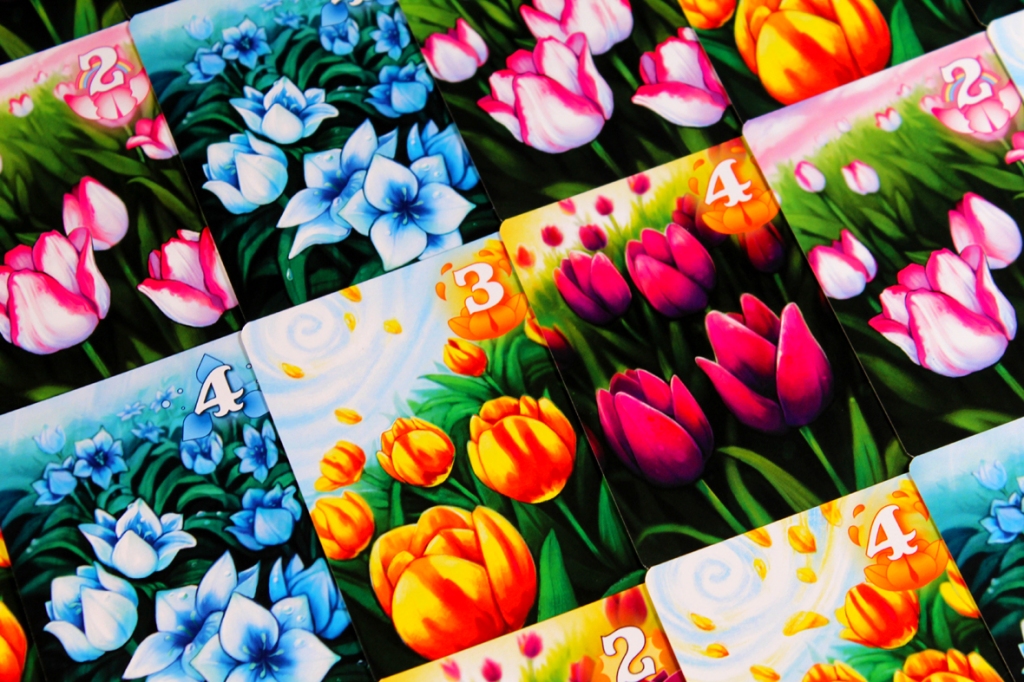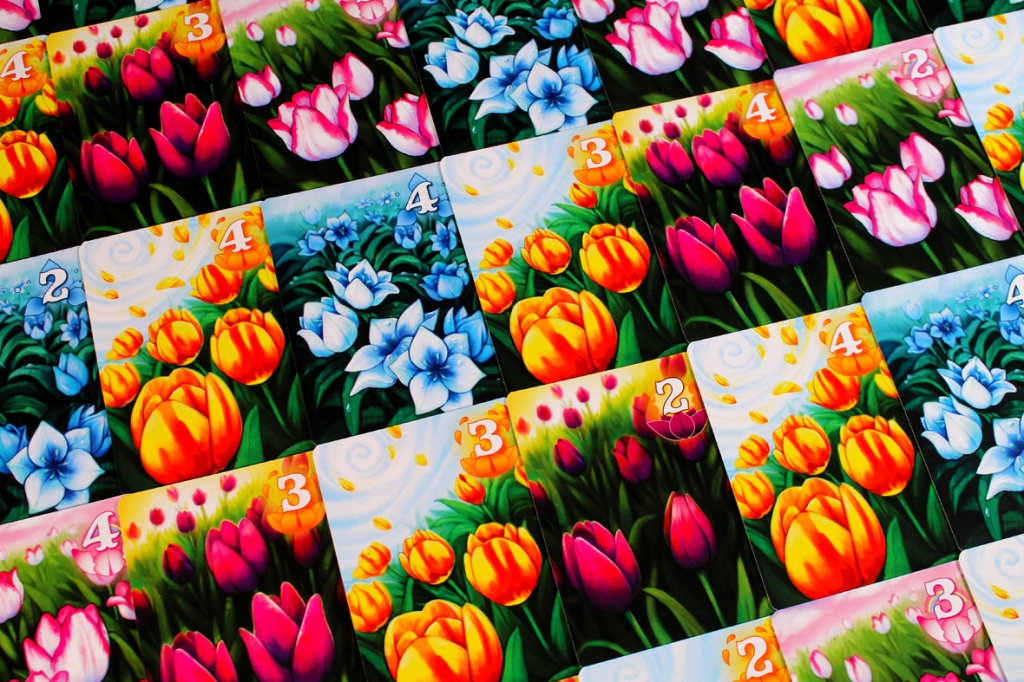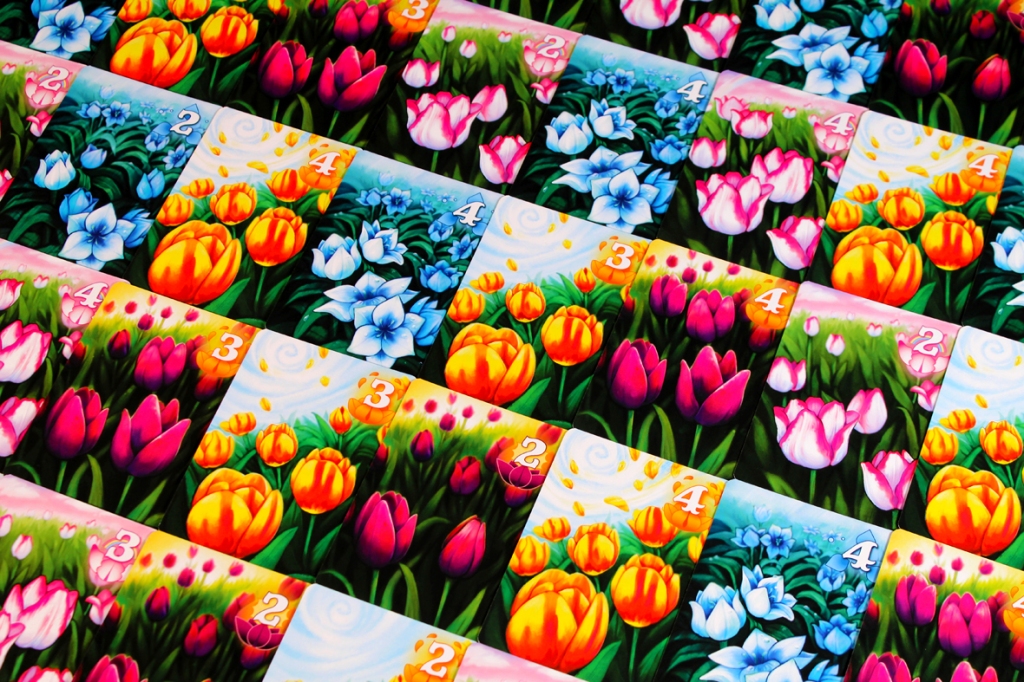
Base price: $19.
1 – 6 players.
Play time: ~20 minutes.
BGG | Board Game Atlas
Check it out on Kickstarter!
Logged plays: 2
Full disclosure: A preview copy of Gift of Tulips was provided by Weird Giraffe Games. Some art, gameplay, or other aspects of the game may change between this preview and the fulfillment of the Kickstarter, should it fund, as this is a preview of a currently unreleased game.
This was certainly one of my riskier Kickstarter agreements, given that this game arrived a few weeks before I moved when I essentially had nobody to play board games with. But we made it work, team, and here we are with a fresh new Kickstarter preview! Just in time for Spring, which helps, especially since this game is so flower-centric. Plus, I’ve had a good time with the Weird Giraffes line in the past, so I figured one more could be a good time. Anyways, let’s dig into Gift of Tulips and see what’s going on here!
In Gift of Tulips, you find yourself in Amsterdam during the annual tulip festival. Naturally, you participate, because it would be rude not to. You find that not only are you trying to keep valuable tulips for yourself, but you’re also likely going to need to give some away to endear yourself to your opponents in your quest for floral mastery. That’s okay, you tell yourself, because you can also work the backend and manipulate the relative values of the flowers in the Festival. It’s a bit shady, since you’re giving someone a tulip and then immediately devaluing it, but, all’s fair in love, flowers, war, and a few other things. Will you be able to win by yourself, or will you end up having to go Dutch?
Contents
Setup
The game isn’t too bad to set up. First, remove the 5/6 player tulip cards if you’re not playing with that many people, and then shuffle the remainder:
Then, remove some cards based on your player count at random, and place them out of play.
- 2 players: 18 cards.
- 3 players: 4 cards.
- 4 players: 18 cards.
- 5 players: 14 cards.
- 6 players: 10 cards.
Next, you’re going to give players a scoring card:

Pass them player cubes, as well. They can choose any color they’d like.

Set out the Festival cards, as well as the Tulip Value Tracking Card:
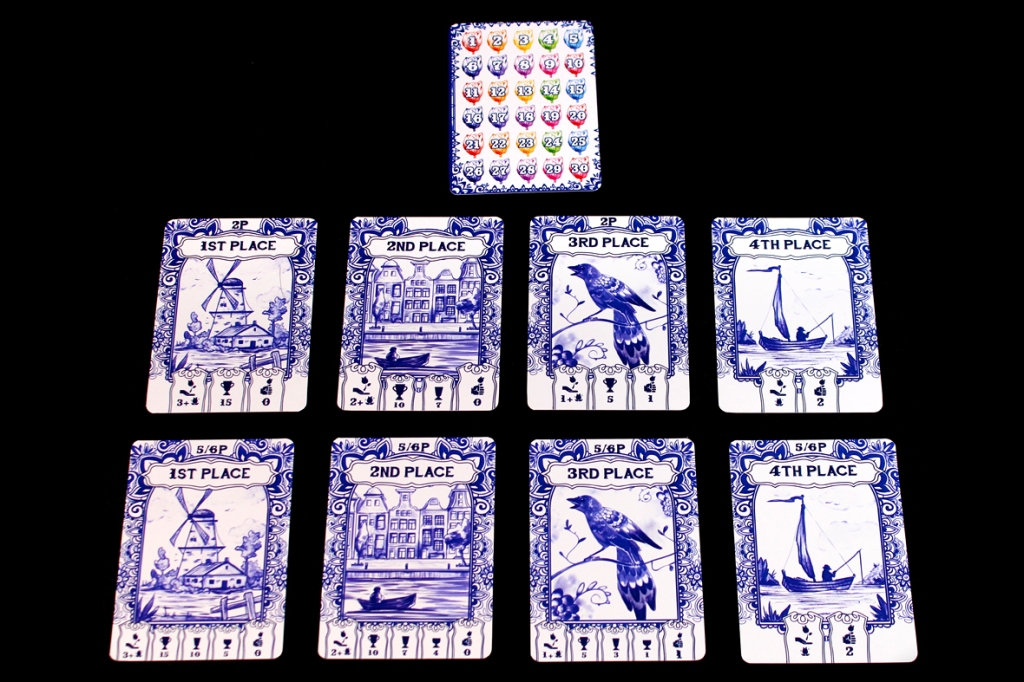
Draw two cards randomly from your tulip deck (making sure they’re different types!), and place the higher one below the 1st Place and the lower below the 2nd Place card. If they’re the same value, break ties arbitrarily. Place each color’s Tulip Value Tracking Cube on the card’s value on the Tulip Value Tracking Card. It should be between 2 and 4.

Finally, deal each player 2 cards. They should keep one to place in front of them (creating their initial Bouquet) and place the other face-down into the Secret Festival Deck (above the Festival cards).
Once you’ve done that, you’re ready to start!
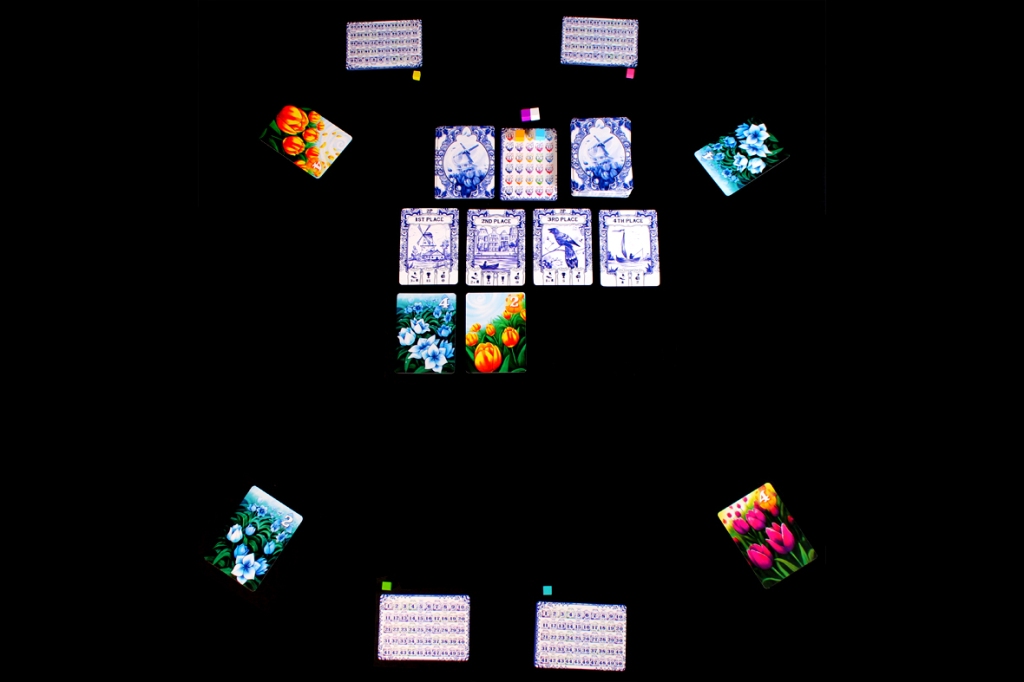
Gameplay
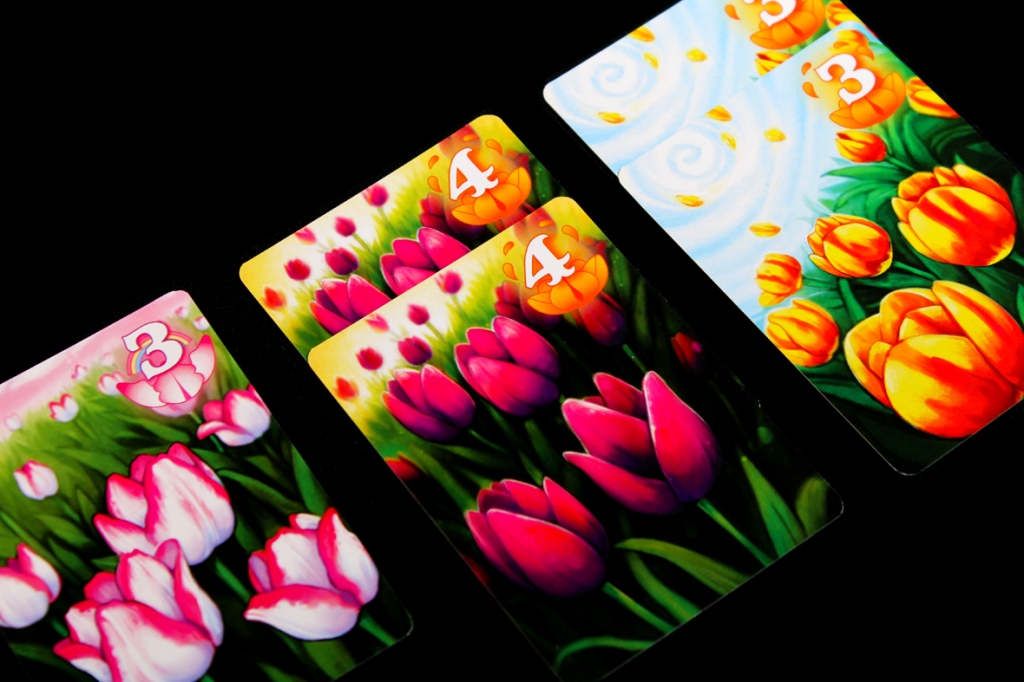
A game of Gift of Tulips is relatively low-complexity. Your goal is to end up with the most valuable flowers by giving, taking, and valuing flowers during the tulip festival. As you do that, different colors will rise and fall in value. If you can manipulate the Festival, then you can end up with the most valuable flowers of all! Is that ethical? Who knows.
On your turn, you will draw and play two cards. Each time you draw a card, you must immediately play it into one of three possible areas. You then draw another card, and play it again. The important caveat is that you cannot perform the same action twice!
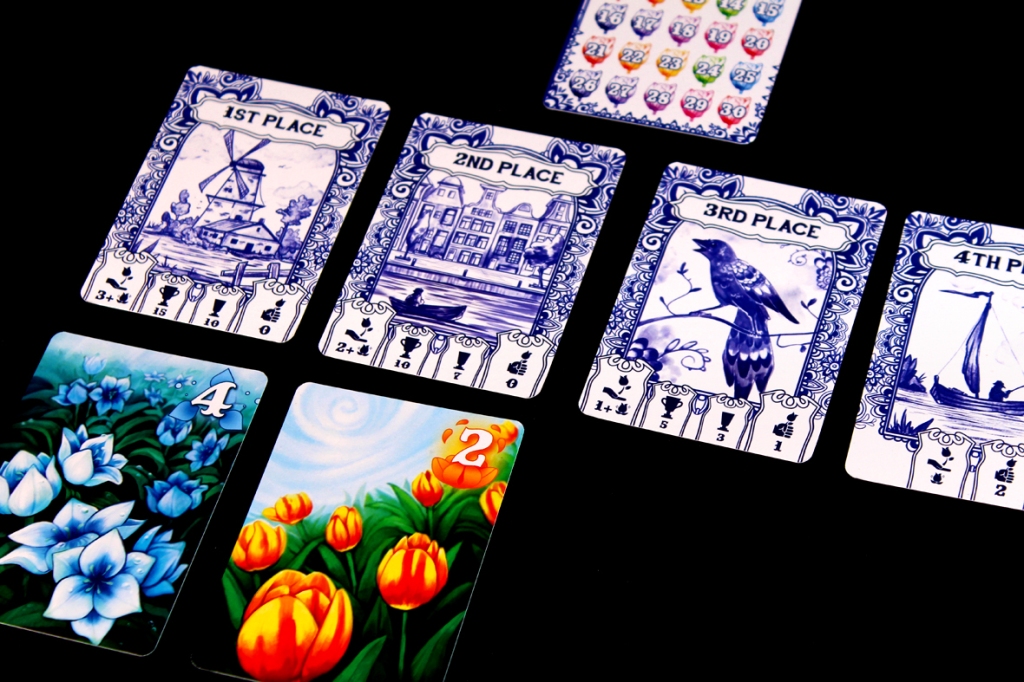
Keep a Tulip
If you keep a tulip, you place it in your bouquet and potentially score points. The lower rank that tulip holds in the Festival, the more points you get (max 2). Plus, it helps you potentially get a majority bonus at the end of the game!
Give a Tulip
You can also kindly give a tulip to an opponent, but every gift has its own price! Giving an opponent a tulip earns you points based on that tulip’s value and its rank in the Festival (the tulip’s value + 0 to 3, depending on the rank). The more highly sought after the tulip, the more valuable of a gift it becomes! Which makes sense, I suppose.
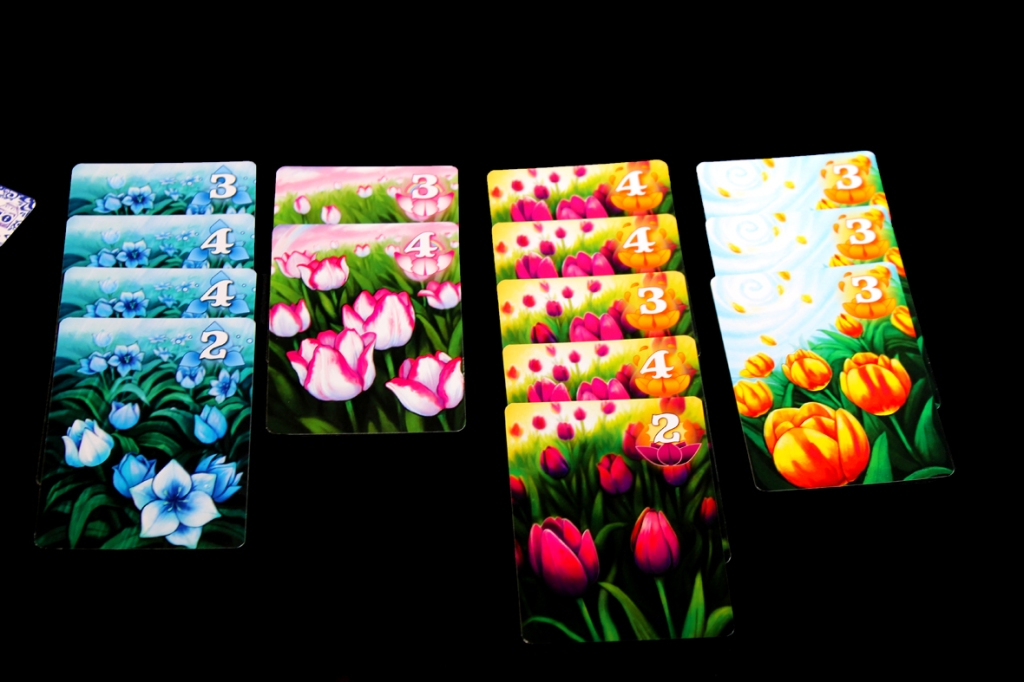
Add to Festival
If you’ve got nothing else to do, then you can use your tulip card to influence the ranking of other tulips in the Festival! You can do this one of two ways.
The first way is by adding the card directly to the festival in the center. All four colors will likely end up in the center at some point. If a card color is not present, it’s considered fourth-ranked. Otherwise, when you add a card to the Festival, place it as part of a splayed stack of that color (so you can see all the values). Calculate the total value of the stack; if it’s equal to or higher than the stack to its left, swap places until it is either the leftmost stack or the stack to its left is a higher total value. Make sure to keep track of the value on the tracker card, as well!
If you’d prefer a bit more random subterfuge, you may instead add your card to the Secret Festival deck, face-down. Maybe it will bail you out later!
End of Game
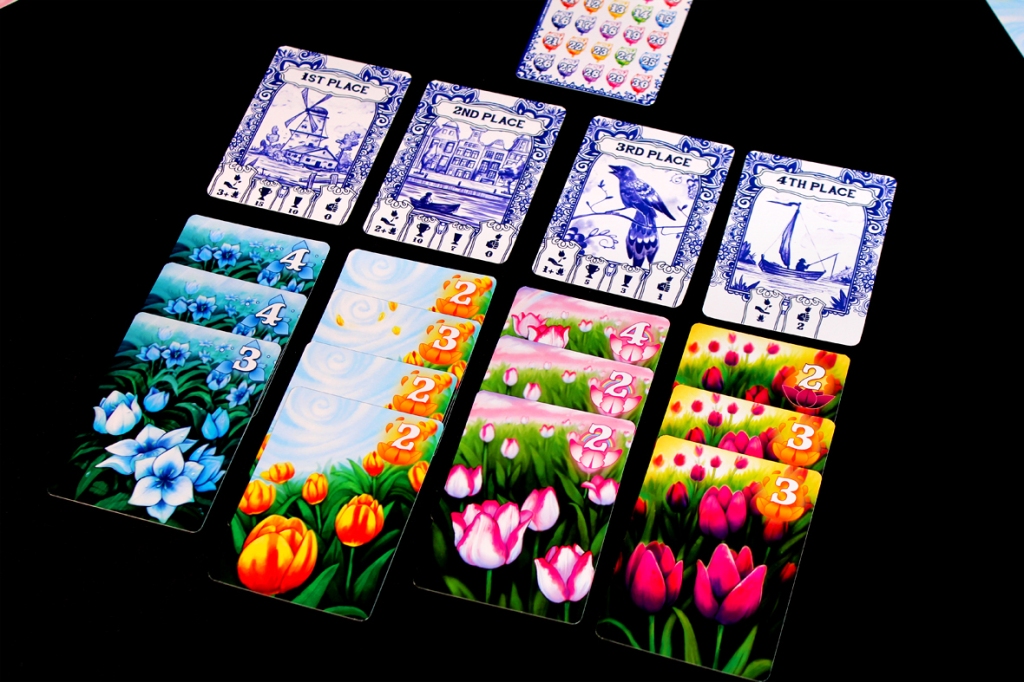
Once the deck runs out of cards, it’s game over! Now, it’s time to calculate majorities. But before you can do that, you have to look at the results of the Secret Festival!
Shuffle the Secret Festival Deck and draw 5 cards from it, adding them to the Festival immediately (but one at a time). Treat them as though they were added via the Add to Festival action and reassign places accordingly.
Once that’s done, calculate majority scoring! The player with the highest total value in each color gains points equal to the number printed on that color’s place card in the Festival. If it has a smaller trophy on it as well, the second (or even third) place player gets points, too!
After that, total scores, and the player with the most points wins!
Player Count Differences
The major difference in this game is sort of what you’d expect in a game where players can independently influence the market, which is that choices made between your turns become increasingly dramatic as more players enter the game, as there are now more turns between your turns. It’s a simple enough concept (and I’ve mentioned this in other reviews), but in Gift of Tulips, it matters a lot as you can get cut out of the Festival if players are gifting tulips to players that aren’t you. Granted, they might be blessing you with flowers, which is great, and at some point they’re inevitably incentivized to give you some tulips if you’re not getting any (because they won’t see you as a threat), but players contributing to the Festival in a way that you don’t want can push those places out of reach between your turn, depending on the players’ luck and what cards get drawn. That can be irritating, but since it’s a game of random card draws, generally one would assume that on a long enough timetable that random effect averages out, somewhat. That said, I have a set of dice in Catan that never rolls a 6, so, who’s to say? I actually quite enjoy this game at two players because the complexity of “who gets the card I give away” is gone; instead, now you have to deal with the tension of giving your rival cards that they might benefit from. It’s fun! It’s sort of why you don’t see an official two-player Catan; the incentive to trade is effectively 0. But I enjoy that! Now you’re trying subterfuge and the Secret Festival and all sorts of tricks. It’s still fun at higher player counts, but the tension at two really draws me in the most.
Strategy
- Keep an eye on who is leading in which colors. This is pretty key to the entire game. If you’re the player leading in a certain color, you may want to choose who you give tulips of that color to so that they can’t usurp your lead. Or maybe you donate them to the Festival to reward your majority? Either way, you should know who the leader is in every color, especially if you’re giving tulips away. You don’t want to make the rich richer, in this game. Or really, in general, but that’s another conversation entirely.
- Particularly, if you’re giving away high-value cards for the points, either make sure that you’re giving it to a player who’s not going to take the lead or you’re putting a player who is behind ahead of a player with more points. My personal favorite thing to do is to put a different player into the lead with my gift, especially if they’re a player who just took their turn before me. This gives other players a chance to “respond”, meaning that they may trick themselves into wasting time undoing my action. That’s great for me, since it likely doesn’t affect me much. Plus, it drives a wedge between two other players and they may take it out on each other instead of me. And that’s good!
- In general, keep in mind that a position is only safe if there’s a value difference of at least 5 between it and the next position. For a position to be “safe”, it really means that it can’t be changed between your turns. This means in a two-player game, if the difference is 5 or more, your opponent cannot place a 4 on something else and make up the difference. In a five- or six-player game, however, there are no truly “safe” positions, since the whole Festival market could be different between your turns. Higher chaos.
- There’s really not much of a point in giving away a 2 in the fourth-place color. If you give it away, you get 2 points. If you keep it, you get 2 points. Unless you’re making a run on the Festival or you want to cause some chaos, keeping it at least gives you a shot at the majority, should that color move into a more valuable place.
- That said, keep in mind that doing one action may limit you in your turn in a way you don’t like or expect. If you keep or give away a card, remember that you can’t do that exact action again this turn. This means that you may want to give away a card in the hopes that you draw a better card that you can keep (or vice-versa). You don’t want to get stuck having to give away a card you’d rather have kept, so try to evaluate when you look at your first card if your choice of actions is critical or if you’d like to leave your options open for your next card draw. If you want to leave things open, then you can always do something else with the card.
- If you want a more chaotic game, only ever contribute to the Secret Festival stack. This is basically the opposite of strategy since it’s pure chaos, but sometimes it’s fun to burn cards to the Secret Festival stack. Nobody knows what you’re placing in there, so, you may see any number of potential outcomes. Is this a good idea for winning? Obviously not; only 5 cards get used out of that stack over the course of the game. But if you’re dumping large numbers in there, you might cause some very unexpected consequences.
- If you overinvest in a color and get too big of a lead, players will just push that color to the bottom of the Festival ordering. You gotta keep them feeling like they’re in the running. Yeah, this is a key thing. You can’t make yourself unbeatable. You need to be one step ahead of your opponents, but not two or three steps. If that happens, they won’t think that chasing you is worth the effort. When that happens, they usually start hurting you by devaluing your hard-earned cards in the market. That’s not good! You hate that! So instead, try to make your opponents feel like they might be able to catch you. Then they’ll waste effort chasing you instead of devaluing the color that you control.
Pros, Mehs, and Cons
Pros
- I love the color scheme. Particularly a big fan of the blue cards, but I’m a sucker for a nice blue color in a game, anyways. It’s known.
- It plays pretty quickly. Yeah, this one’s 20 minutes even with a large group. I bet two players could get through it in 15, if they’re hustling.
- There’s an interesting balance between short- and long-term choices, even for a short game. I like that giving away high-value cards can get you 7 points, if done correctly. Usually, this means if you’re constantly doing that (which would mean you have some pretty lucky draws), you can make pretty good progress without relying on the Festival if you don’t want to. But if you aren’t paying some attention to the Festival, you risk getting entirely left behind by other players (who you have been helping with your various flower donations). So I appreciate having to balance those conflicting force over the course of a short game.
- I like that generally player interaction is positive; it’s only negative player interaction for players that you chose not to interact with. It’s an interesting thing that I’ve been seeing more of in the games I play, which is good! I like that you’re incentivized to “help” (or at least provide something nice) to another player to get a benefit, because the mutual aid aspect of it is interesting. It also makes the game tense at two players, since you really don’t want to be giving players a lot of flowers, unless it’s in a color you already firmly control. But that’s hard to guarantee!
- The game is pretty portable, too. It’s mostly just cards and a few tokens. Again, I like highly portable games, even though portability doesn’t really matter that much right now, but I’m optimistic about the future. Hopefully by the time you get this game off of Kickstarter, you can safely go places again.
- Having a few cards removed at random no matter what the player count is does a nice, simple job of keeping the game hard to track perfectly. No matter how many cards you have, there’s always some player, somewhere, who’s trying to count cards and gather perfect information. Losing a few randomly (and having multiple cards of the same value) can really junk up those counts and obfuscate what the possible remaining cards are, making planning challenging for those players. And that’s good! Need a bit of randomness in light games.
- Similarly, the Secret Festival does a great job of adding in a random element, especially at lower player counts where players can’t dogpile certain colors to the top. I actually like the limit on the Secret Festival, as well, since it means you can try and hope to bump up a color without alerting your opponent to it, which is interesting. Whether or not it works is a function of how many cards are in the pile and, assuming there are more than 5, random chance, but if you can make it work for you it’s a pretty satisfying effect (albeit a random one).
- It’s not a particularly complex game to learn to play, which is nice. Weird Giraffe is, I think, targeting a slightly more gateway-friendly audience than a lot of Kickstarter-based publishers I’ve seen, which is nice. That’s not to say they’re entirely in that camp; I think Stellar Leap and Tumble Town are a bit heavier, certainly, but this game is a nice, lighter title. You don’t have a ton of complex options on your turn, but the options you DO have are still interesting, and that’s good.
Mehs
- If the Secret Festival deck gets overstuffed, the game can get a bit swingy, but that takes a fairly coordinated effort from players for that to happen. It really is just a question of whether or not players want to obviously advance a clear agenda or risk trying to subtly advance an agenda. Only 5 cards get revealed from the Secret Festival, so, it may not be worth your time to add the 15th card to that pile. It just means that the endgame will be fairly random, assuming players haven’t contributed much to the actual Festival. That’s a low-probability event, but if it does happen, it can be odd. For it to happen, though, you would also have to participate in ignoring the Festival proper, so, at that point, it’s kind of on you.
- The rules being a longer document isn’t a big problem beyond your first time, when they take up a lot of space that you could otherwise use for setup. This is a one-time problem, so it ends up in the Mehs. Since the rules document is basically a big page, it takes up a lot of space and is a bit unwieldy. That’s not really a big deal, depending on your table size, and even more so since I didn’t find it critical to go through the rules multiple times (it’s a lower-complexity game, anyways). Like I said, one-time problem.
- Some player turns are definitely just more valuable than others. It amortizes out due to the random nature of the card draws, but it can be a bit annoying as a player when you have a garbage turn and another player immediately after you swings the Festival such that they’ll gain 15 points and gives away a 7-point card, or something. That’s sort of the nature of the game, but it can be frustrating in the moment.
Cons
- Careful when keeping track of your scores. Since the game’s state shifts, if you mess up your score card, it’s difficult to fix. This is sort of due to two different factors. The first and easiest to address is that every player keeps their own score. On one hand, a lot of games in which players keep their own score do so to prevent players from being annoying and always trying to see what their opponents have. This has public scoring, so, that doesn’t solve that issue. A shared scoreboard in the center might (and it reduces the chances of accidental [or otherwise] score modifications). The problem that is more difficult to address is that this game, like many others, is not a game where you can recreate previous states. That’s fine and that happens, but it also means that if you knock your scorecard off the table, you’d best hope that other players remember what your score was at the start of your turn or you might be hosed. It’s a lighter con, but still worth mentioning.
- I think that in general, games where players can coordinate to change the market can irritate me a bit at higher player counts as the market can swing away from you between turns to such a point that it is hard to correct. I’d call this a form of dogpiling, but essentially instead of attacking your units or something, your opponents are coordinating (intentionally or otherwise) to devalue your investments. That’s probably why it irks me, since it still reads as dogpiling, to me, even though it may be entirely unintentional. Since so many turns happen between your turns, it may be hard to singularly control one interest at higher player counts, which may feel somewhat frustrating. My solution to this generally remains playing at lower player counts, where I feel I can exert more control over the game.
Overall: 7.5 / 10
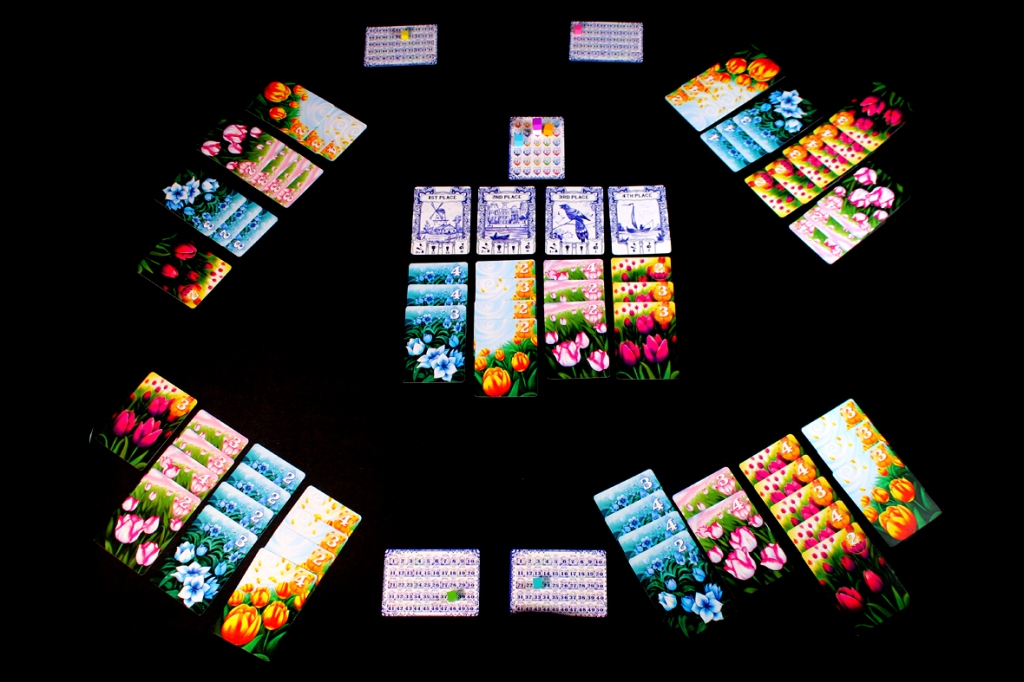
Overall, I think Gift of Tulips is a cute and quick little game. It appeals to my desire for a quick, simple, and pretty game, and I think it lands it pretty well, in that regard. I like the two different luck elements that are present in the game quite a bit — pushing your luck and hoping that your second card works well with the actions you have left for it, and burying cards in the Secret Festival and hoping for the best. It’s neat! There are, of course, some weird effects that can happen if players mostly conspire to mess with the market (and get lucky enough to do so), but that usually depends on higher player count games and some weird behaviors, so I’m hoping even if you can find 5 people to play this with, that won’t happen too often. My other major gripe is with the size of the player scoring cards, but I assume that’s largely done so that there are only cards and some cubes in the game (for maximum portability). I understand why it’s done, but I would definitely prefer an actual scoreboard because I’m just … incredibly clumsy and will 100% knock the card off the table at least once and mess up my score. It’s all but guaranteed. Beyond that, though, I’ve had a good amount of fun with the game! It’s quick and largely simple, as I mentioned, and the random elements are happening to every player, every turn, so they do kind of average out over the course of the game to make the game feel strategic, rather than purely random chance. It’s a good exercise in demonstrating how random chance can lend itself well to strategic thinking, however, since your cards are always essentially random (especially as there’s no way to really predict them beyond aggressive counting and probabilities). Gift of Tulips is on the lighter end of the Weird Giraffes line, but it’s definitely not out of place. If you’re looking for a quick game of turning random chance into positive fortune, then I’d recommend checking Gift of Tulips out! I had fun with it.
